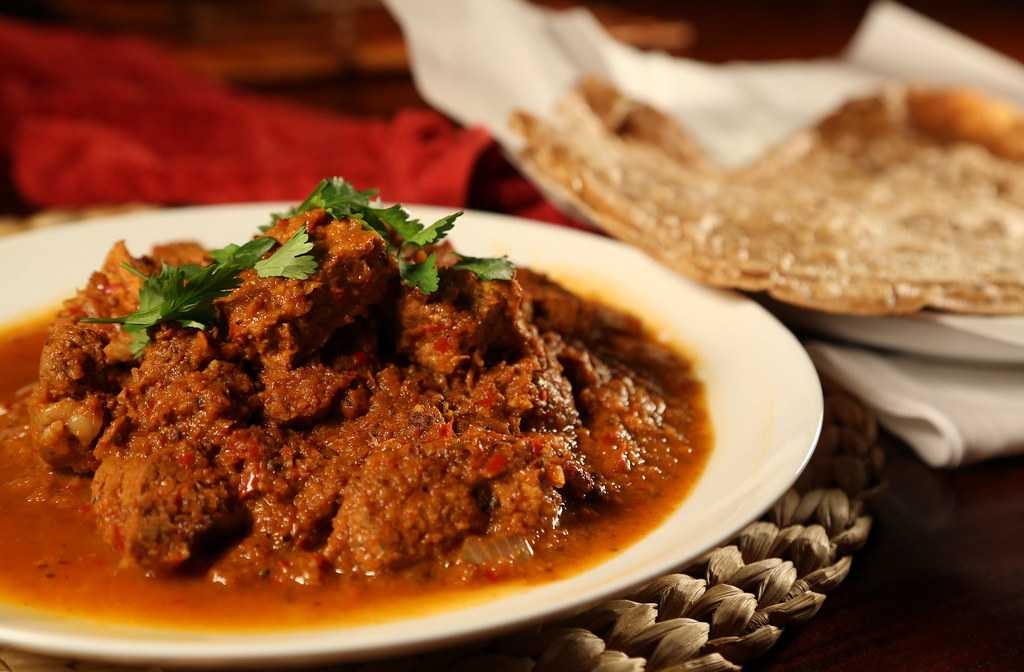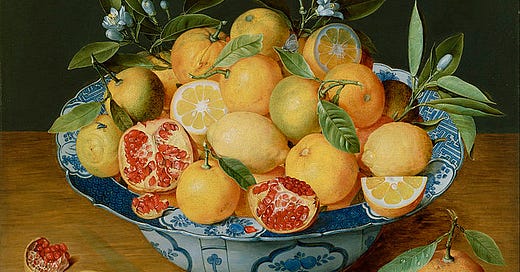Did you know… that some of the earliest known evidence of citrus comes from Bavaria?1 The fossilized wood dates to 23- to 5-million years ago, so well before humans migrated to Europe, but I’d love to imagine ancient Germans flavoring their pretzels with bergamot.
The Root of Fruit
Lately, I’ve wondered about the history of fruits—where they came from, how humans learned to cultivate them, etc. For instance, I don’t think I’d have been the first human to put a rambutan in my mouth… although, I’m glad that someone did, because they’re delicious.
In search of answers, I purchased this book by British botanist David J. Mabberley called Citrus: A World History. Citrus is the focal point of this book, as the name would suggest, but Mabberley covers a global view of the genus. And while I’ve only skimmed through it thus far, I’m impressed with the quality of its content. Beautiful illustrations decorate half the book, with interesting facts and stories occupying the rest of the pages.
For instance, I learned that, long before industrial cultivation, monkeys distributed mandarin oranges across Japan, and birds kumquats.2 Some intrepid oranges transported themselves by currents across the Pacific Ocean, and took root on islands like Fiji.
Another source of spreading citrus around the world was scurvy—or, rather, sailors’ efforts to combat it.3 In the 16th and 17th centuries, Portuguese sailors loaded their vessels with about as many pounds of oranges as they did spices, and even planted fruit trees on the mid-Atlantic island of St. Helena to avoid high fatality rates on their voyages back to Lisbon.
All that is to say, this field seems like a gold mine for me, and I look forward to writing you a summary of Mabberley’s book in the future.
Vinda-Who?
A couple of months ago, my friend Aditya got me hooked on this podcast called Empire. Per the podcast’s description on Spotify, its two hosts, Anita Anand and William Dalrymple, “explore the stories, personalities and events of empire over the course of history.” If you enjoy passionate prose, twisting stories, and good-humored personalities, then this podcast is for you.
In a recent episode, the hosts launched into a digression about Vindaloo. I had never thought much about the dish before, having seen it included in the pan-Indian fare at most South Asian restaurants. Why spotlight it in particular?
Well, because it’s rather singular in Indian cuisine in that it’s not from India. Not originally, at least.
While the dish is associated with Goa, Vindaloo’s origins come from over 5,200 miles to the west. When the Portuguese conquered Goa from the Bijapur Sultanate in 1510, they brought with them meat preserved in barrels of vinegary wine and garlic, hence the name "Vinha De Alhos” in Portuguese (which was localized to “Vindaloo”). This mixture of cooked meat was watery and very unlike the modern Vindaloo that you’d make at home or order out.
Once introduced to Goa, the city transformed the dish by incorporating local spices—black pepper, cardamom, and cinnamon. Globalization in the age of European imperialism delivered the final key ingredient: the chili pepper.
Believe it or not, chili was not present in any Indian food until the 15th century, and wasn’t widely incorporated across the sub-continent until the 18th century. Chilis hail from South America, originating in the lowlands of Brazil. While they are one of the oldest cultivated crops across the Americas, they weren’t present in the Eastern Hemisphere until the birth of the Portuguese Empire. Trading ships brought the chili from Brazil to the coasts of Africa, the Arabian Peninsula, India, and Southeast Asia. Chili made Vindaloo the fiery staple of Indian cuisine that we enjoy today.

Upcoming Posts
You may have noticed a Portuguese theme running through this post. That’s not a coincidence, since Portugal is the topic of my first Book Summary, which should appear in your inboxes next week. I’m nearly finished with Conquerors: How Portugal Forged the First Global Empire by Roger Crowley and have much to say. I found the narrative to be sometimes hilarious, sometimes horrifying, but completely entertaining. Hopefully, I can do Crowley’s prose justice.
Additionally, for you paid subscribers, I’m working away at the inaugural entry to my first Deep Dive series, the Medieval Roman Empire (a.k.a., the Byzantine Empire). For anyone that knows me, this choice isn’t much of a surprise. The overlooked millennium of Roman history has been a lifelong obsession of mine. I’ve collected a vast repository of dramas, comedies, and tragedies that would give Game of Thrones or Succession a run for their money. More than that, I hope to share with you the tethers between their past and our present that keep us connected today—from our civil law systems to the fork.

If you’ve not purchased a paid membership, I’ll still share a preview of the Deep Dive with you at the same time it goes out to paid subscribers.
Best wishes for the weekend,
Blake, author of Affirmative Containership
Sources (print):
Mabberley, David J., “Introduction,” in Citrus: A World History. (London: Thames & Hudson, 2024), 19.
Mabberley, Citrus, 22.
Mabberley, Citrus, 153-3.






Blake, this is very cools stuff. Back in the 15th Century, the Portuguese were an adventurous crew. In middle school we read about Prince Henry the Navigator, the trade routes to India and all of that. But we didn’t get the real story. They went to West Africa looking for gold (the ‘Gold Coast), but ended up trading for slaves, whom they initially exported to Europe. The fateful deal was done over the world’s first blockbuster drug trade: sugar. Initially on Sao Tome and Madeira, they developed the industrial sugar plantation based on enslaved labor. That model, later adapted to cotton, spread to the Caribbean, Brazil, and North America.